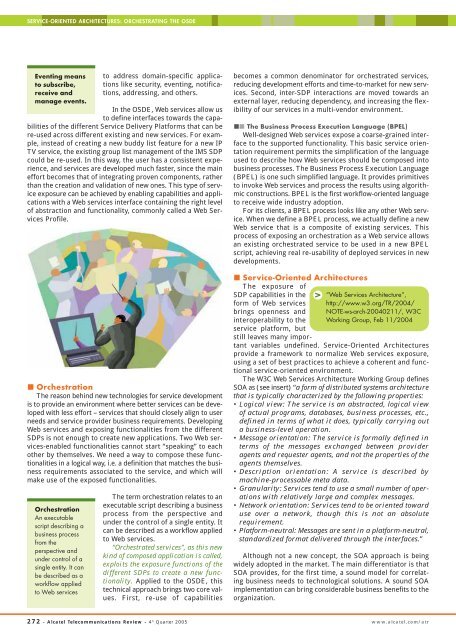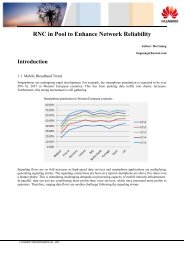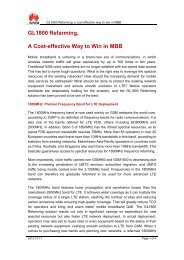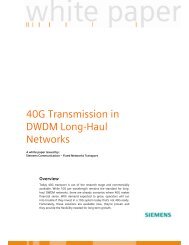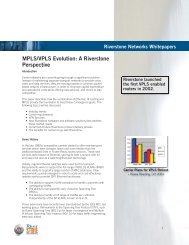report - Light Reading
report - Light Reading
report - Light Reading
You also want an ePaper? Increase the reach of your titles
YUMPU automatically turns print PDFs into web optimized ePapers that Google loves.
SERVICE-ORIENTED ARCHITECTURES: ORCHESTRATING THE OSDE<br />
Eventing means<br />
to subscribe,<br />
receive and<br />
manage events.<br />
to address domain-specific applications<br />
like security, eventing, notifications,<br />
addressing, and others.<br />
In the OSDE, Web services allow us<br />
to define interfaces towards the capabilities<br />
of the different Service Delivery Platforms that can be<br />
re-used across different existing and new services. For example,<br />
instead of creating a new buddy list feature for a new IP<br />
TV service, the existing group list management of the IMS SDP<br />
could be re-used. In this way, the user has a consistent experience,<br />
and services are developed much faster, since the main<br />
effort becomes that of integrating proven components, rather<br />
than the creation and validation of new ones. This type of service<br />
exposure can be achieved by enabling capabilities and applications<br />
with a Web services interface containing the right level<br />
of abstraction and functionality, commonly called a Web Services<br />
Profile.<br />
Orchestration<br />
The reason behind new technologies for service development<br />
is to provide an environment where better services can be developed<br />
with less effort – services that should closely align to user<br />
needs and service provider business requirements. Developing<br />
Web services and exposing functionalities from the different<br />
SDPs is not enough to create new applications. Two Web services-enabled<br />
functionalities cannot start “speaking” to each<br />
other by themselves. We need a way to compose these functionalities<br />
in a logical way, i.e. a definition that matches the business<br />
requirements associated to the service, and which will<br />
make use of the exposed functionalities.<br />
Orchestration<br />
An executable<br />
script describing a<br />
business process<br />
from the<br />
perspective and<br />
under control of a<br />
single entity. It can<br />
be described as a<br />
workflow applied<br />
to Web services<br />
The term orchestration relates to an<br />
executable script describing a business<br />
process from the perspective and<br />
under the control of a single entity. It<br />
can be described as a workflow applied<br />
to Web services.<br />
“Orchestrated services”, as this new<br />
kind of composed application is called,<br />
exploits the exposure functions of the<br />
different SDPs to create a new functionality.<br />
Applied to the OSDE, this<br />
technical approach brings two core values.<br />
First, re-use of capabilities<br />
becomes a common denominator for orchestrated services,<br />
reducing development efforts and time-to-market for new services.<br />
Second, inter-SDP interactions are moved towards an<br />
external layer, reducing dependency, and increasing the flexibility<br />
of our services in a multi-vendor environment.<br />
The Business Process Execution Language (BPEL)<br />
Well-designed Web services expose a coarse-grained interface<br />
to the supported functionality. This basic service orientation<br />
requirement permits the simplification of the language<br />
used to describe how Web services should be composed into<br />
business processes. The Business Process Execution Language<br />
(BPEL) is one such simplified language. It provides primitives<br />
to invoke Web services and process the results using algorithmic<br />
constructions. BPEL is the first workflow-oriented language<br />
to receive wide industry adoption.<br />
For its clients, a BPEL process looks like any other Web service.<br />
When we define a BPEL process, we actually define a new<br />
Web service that is a composite of existing services. This<br />
process of exposing an orchestration as a Web service allows<br />
an existing orchestrated service to be used in a new BPEL<br />
script, achieving real re-usability of deployed services in new<br />
developments.<br />
Service-Oriented Architectures<br />
The exposure of<br />
SDP capabilities in the<br />
form of Web services<br />
brings openness and<br />
interoperability to the<br />
service platform, but<br />
still leaves many impor-<br />
“Web Services Architecture”,<br />
http://www.w3.org/TR/2004/<br />
NOTE-ws-arch-20040211/, W3C<br />
Working Group, Feb 11/2004<br />
tant variables undefined. Service-Oriented Architectures<br />
provide a framework to normalize Web services exposure,<br />
using a set of best practices to achieve a coherent and functional<br />
service-oriented environment.<br />
The W3C Web Services Architecture Working Group defines<br />
SOA as (see insert) “a form of distributed systems architecture<br />
that is typically characterized by the following properties:<br />
• Logical view: The service is an abstracted, logical view<br />
of actual programs, databases, business processes, etc.,<br />
defined in terms of what it does, typically carrying out<br />
a business-level operation.<br />
• Message orientation: The service is formally defined in<br />
terms of the messages exchanged between provider<br />
agents and requester agents, and not the properties of the<br />
agents themselves.<br />
• Description orientation: A service is described by<br />
machine-processable meta data.<br />
• Granularity: Services tend to use a small number of operations<br />
with relatively large and complex messages.<br />
• Network orientation: Services tend to be oriented toward<br />
use over a network, though this is not an absolute<br />
requirement.<br />
• Platform-neutral: Messages are sent in a platform-neutral,<br />
standardized format delivered through the interfaces.”<br />
Although not a new concept, the SOA approach is being<br />
widely adopted in the market. The main differentiator is that<br />
SOA provides, for the first time, a sound model for correlating<br />
business needs to technological solutions. A sound SOA<br />
implementation can bring considerable business benefits to the<br />
organization.<br />
272 - Alcatel Telecommunications Review - 4 th Quarter 2005 www.alcatel.com/atr<br />
>


